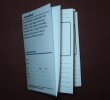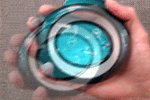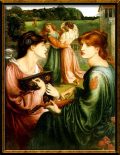I would be ready to practise any job if by doing so I could achieve great wealth by honest means. On the contrary, if in order to become rich I had to make use of dishonourable means, I would prefer to stay poor, dedicated to my favourite activities.
Author: jose
Make a notebook, and make it easy: Pocketmod
The PocketMod is a small book with guides on each page. These guides or templates, combined with a unique folding style, enable a normal piece of paper to become the ultimate note card.
 The interest of pocketmod lies in the way it merges several useful related ideas into a single, solid initiative. There’s a set of handy templates (or mods, as they call them) to choose from; an intuitive application to arrange them into a custom notebook; a way to make this application as accesible as possible (you can either design and print the notebook right from the browser, or download the software and use it offline); a clever folding pattern so that the notebook is quickly made from the printed piece of paper; and a tool to convert previously made documents (in pdf format) to a ready-to-fold booklet (or series of booklets, if needed).
The interest of pocketmod lies in the way it merges several useful related ideas into a single, solid initiative. There’s a set of handy templates (or mods, as they call them) to choose from; an intuitive application to arrange them into a custom notebook; a way to make this application as accesible as possible (you can either design and print the notebook right from the browser, or download the software and use it offline); a clever folding pattern so that the notebook is quickly made from the printed piece of paper; and a tool to convert previously made documents (in pdf format) to a ready-to-fold booklet (or series of booklets, if needed).
I find that the folding technique leaves too much paper unused (one side, actually), but after trying several alternatives I believe that actually the authors went for the easiest way to get the book ready. Anyway, the forum is a good source for further mods and ideas. Now you can say goodbye to sketching on paper napkins!
ps. Still, if you must use a napkin, remember the folding pattern: you’ll get a notebook as small as it is cool 🙂
Related Article: All you need to make a notebook
en(-v)eloop batteries by sanyo
I found out that sanyo has released a new brand of batteries whose name and design (in my opinion) closely resemble my own name and logo. I don’t know whether this is a coincidence or not, but at least I can show the facts:
This is my homepage:
This is the eneloop batteries´ press release:
http://www.sanyo.co.jp/koho/hypertext4-eng/0511/1101-2e.html
And this is another logo of mine that I was already using in my projects:
Confucius of the day
Those who do not study, or study but do not obtain a profit, must not get discouraged, nor end their path. Those who do not ask in order to solve their doubts, or who ask but do not get satisfactory answers, they must not get discouraged either. Those who do not practice meditation, or when meditating do not obtain a clear knowledge of the foundation of goodness, they must not get discouraged. Those who still cannot distinguish good from evil, or those who do distinguish but have not managed to penetrate the essence of goodness, they should not get discouraged. Those who do not practice goodness or when doing so do not manage to do it with all their strength, they should not get discouraged either. What others would do in their first attempt, they will achieve in ten attempts; what others would do after a hundred attempts, they will do after a thousand.
He who truly follows this rule of persistance, no matter how ignorant, he will become wise without realizing; no matter how weak, he will naturally become strong.
Blogging with WordPress: my favourite plugins
 (Last Updated 18.09.06) A few days ago I talked to a friend about the convenience of changing his site into a blog format. He liked the idea, and since I had told him about the benefits of using plugins to add functionality and customize the blog, he later wrote me an email asking me if I could save him some time by telling him which plugins I use. Here is the list (I’m using WordPress v1.5): Continue reading Blogging with WordPress: my favourite plugins
(Last Updated 18.09.06) A few days ago I talked to a friend about the convenience of changing his site into a blog format. He liked the idea, and since I had told him about the benefits of using plugins to add functionality and customize the blog, he later wrote me an email asking me if I could save him some time by telling him which plugins I use. Here is the list (I’m using WordPress v1.5): Continue reading Blogging with WordPress: my favourite plugins
Shake that waterscape,
or the maraca PDA
http://hhil.hitachi.co.jp/products/waterscape-e.html
To allow browsing of information in a passive and relaxed way, we have developed a prototype personal digital assistant (PDA) terminal with no buttons at all. By operating the terminal with simple tilting and shaking gestures, contents such as movies and music can be enjoyed.
 In a former article (see below), I wrote about the increasing importance of what I called “gestural control”, which I had already been following in relation to musical intruments and seems to be slowly finding its way into everyday life (it even went mainstream when it was used in the videogame “Black&White”, for instance). In this case, Hitachi shows us a little neat device, merely a screen, where several icons (bubbles) literally “float” around. Tilting the device will displace those bubbles in such a way that when one of them gets to a “hotspot”, located in the center of the screen, it will reveal its contents, which the user can select in the same way. A second different gesture, that of shaking the device, provides a means to “go back” or deselect the current feature.
In a former article (see below), I wrote about the increasing importance of what I called “gestural control”, which I had already been following in relation to musical intruments and seems to be slowly finding its way into everyday life (it even went mainstream when it was used in the videogame “Black&White”, for instance). In this case, Hitachi shows us a little neat device, merely a screen, where several icons (bubbles) literally “float” around. Tilting the device will displace those bubbles in such a way that when one of them gets to a “hotspot”, located in the center of the screen, it will reveal its contents, which the user can select in the same way. A second different gesture, that of shaking the device, provides a means to “go back” or deselect the current feature.
As a prototype, the waterscape is a study for new, more intuitive ways of accessing data in electronic devices. However, there are Continue reading Shake that waterscape,
Adding an image to Black-Letterhead theme
Last Updated 23.02.06
Black-Letterhead is the name of the theme that I’m using as the layout for this site. It took me quite some time to figure out how to add the image for the header, and when searching for information I couldn’t find an “easy” answer; that’s why I decided to show here the code that I changed in case it may be of help to others. (disclaimer: I’m anything but an expert in this field, so I don’t know if it will work for you -but it has worked for me). Continue reading Adding an image to Black-Letterhead theme
Guess what, guess who?
or the Mystery Masterpiece contest
http://www.wetcanvas.com/forums/forumdisplay.php?f=24
I will present a somewhat obscure work to be identified by title and artist.
Every few days I’ll check back to review your answers. The first to post the correct information will be the winner and get to post the next one. He/she will then determin the winner and it will pass on to them and so on and so on and so on…
 While browsing through the Wetcanvas forums I came across this initiative, which I find equally amusing and educational. It just takes a small bit of interest, if not simple curiosity, to dip into the list of proposed artworks (1016 so far), and I warn you that in between guessing, discovering and reading the comments you will easily spend quite some time there; however, time spent this way I believe to be a true investment! 🙂
While browsing through the Wetcanvas forums I came across this initiative, which I find equally amusing and educational. It just takes a small bit of interest, if not simple curiosity, to dip into the list of proposed artworks (1016 so far), and I warn you that in between guessing, discovering and reading the comments you will easily spend quite some time there; however, time spent this way I believe to be a true investment! 🙂
Confucius of the day
Pulsars, Planets, Poms
Pulsars
http://www.jb.man.ac.uk/~pulsar/Education/Sounds/sounds.html
 A pulsar is a highly magnetised neutron star, with a radius of 10-15 km, having somewhat greater mass than the Sun which has a radius of approximately 1 million km. Radiation is beamed out along the magnetic poles and pulses of radiation are received as the beam crosses the Earth, in the same manner as the beam from a lighthouse causes flashes.
A pulsar is a highly magnetised neutron star, with a radius of 10-15 km, having somewhat greater mass than the Sun which has a radius of approximately 1 million km. Radiation is beamed out along the magnetic poles and pulses of radiation are received as the beam crosses the Earth, in the same manner as the beam from a lighthouse causes flashes.
Listen to the sound of a Pulsar
Planets
http://www.nasa.gov/mission_pages/cassini/multimedia/pia07966.html
 Saturn is a source of intense radio emissions, which have been monitored by the Cassini spacecraft. The radio waves are closely related to the auroras near the poles of the planet. These auroras are similar to Earth’s northern and southern lights. This is an audio file of radio emissions from Saturn.
Saturn is a source of intense radio emissions, which have been monitored by the Cassini spacecraft. The radio waves are closely related to the auroras near the poles of the planet. These auroras are similar to Earth’s northern and southern lights. This is an audio file of radio emissions from Saturn.
Listen to the eerie Sounds of Saturn’s Radio Emissions
Poms
http://www.envelooponline.com/main.htm
 POM is the short for Petit Objet Musical, that is, a Little Musical Object (…)They are offered as landscapes or “living sculptures”(…)I record typically two to three minutes as to get a detailed image of all the nuances in the sound, but these are only windows into conceptually infinite pieces.
POM is the short for Petit Objet Musical, that is, a Little Musical Object (…)They are offered as landscapes or “living sculptures”(…)I record typically two to three minutes as to get a detailed image of all the nuances in the sound, but these are only windows into conceptually infinite pieces.
Listen to Pom n.17 (which I also call “Forbidden Planet”, after the soundtrack of the classic movie).
Source: musicthing
